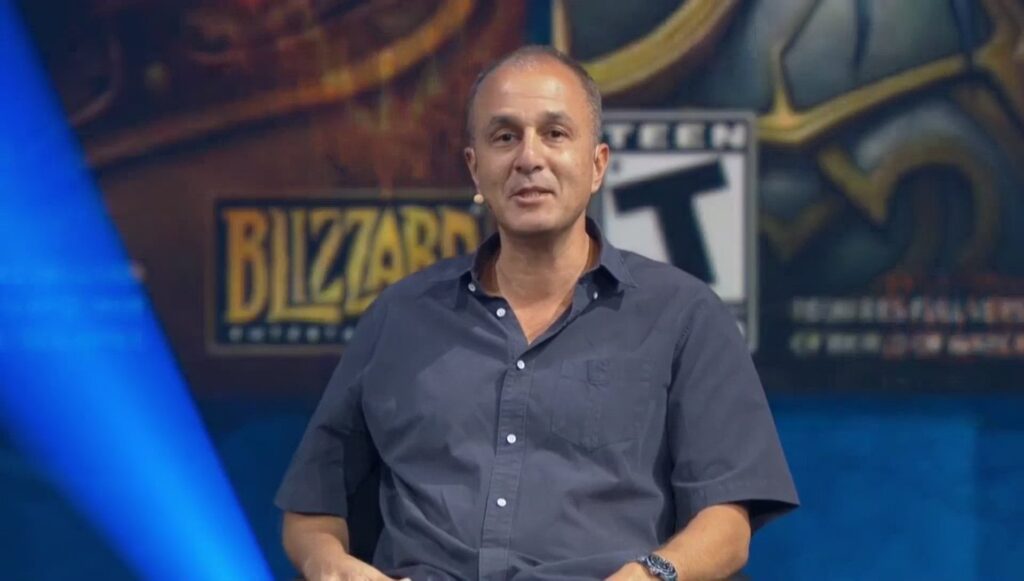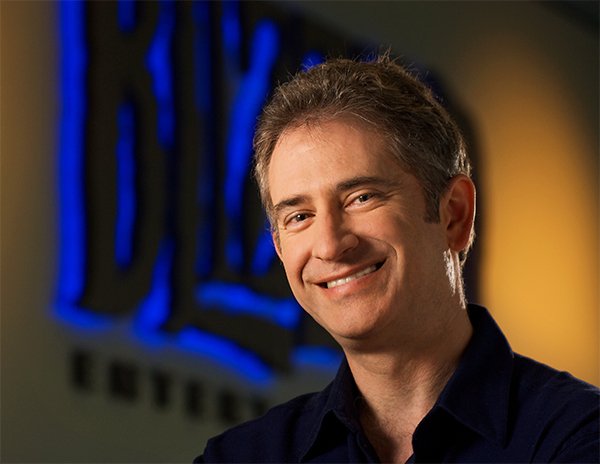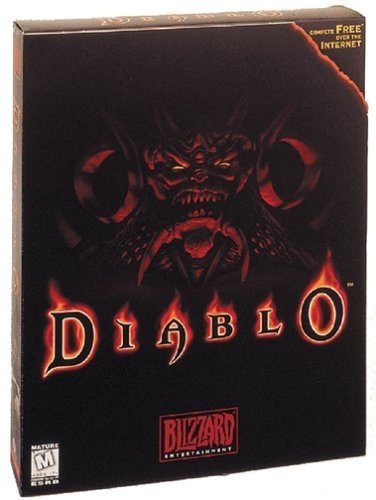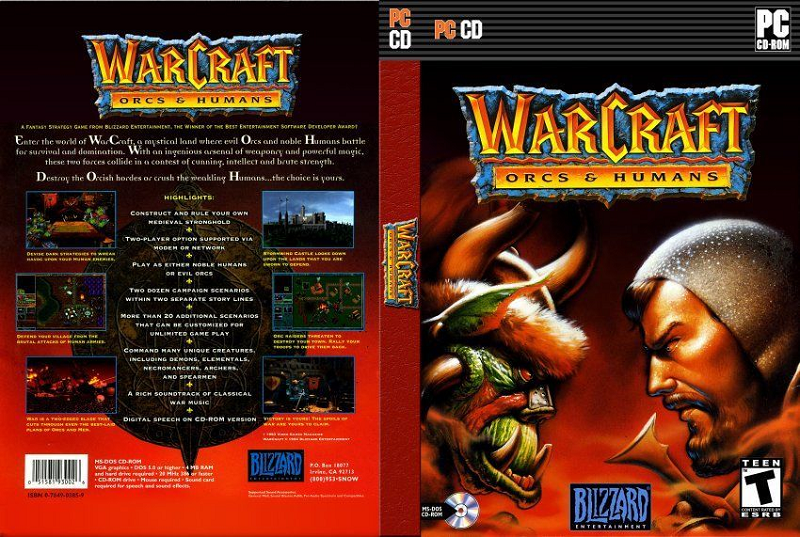
Blizzard co-founder Allen Adham has helped create some of my all-time favorite games, including the studio’s flagship game, World of Warcraft. But the real magic hasn’t been in the games themselves. It’s found in the people that make them. What struck me first about Adham was the way in which he moves through the world — with empathy and sincerity. He’s the kind of person who could make inane weather chatter something that might border on profundity.
Adham’s return to Blizzard after a 12-year absence has become somewhat of a bittersweet prospect, especially as his friend (Blizzard’s long-time president) Mike Morhaime steps down and J. Allen Brack takes his place.

“When he told me the news, it was definitely a combination of both sadness and happiness,” Adham admitted to GameDaily during BlizzCon 2018. “I’m very happy for Mike to be able to enjoy kind of the fruits of all those years of hard work. [I’m] a little jealous that he’s going to get to travel around the world [and] have a bunch of good times. But at the same time, he’s going to miss out on the next sort of phase of all the great things we have sort of in the pipeline.”
As Morhaime sets his sights on sipping cocktails and spending well-earned time with his family, Adham is confident in Blizzard’s future under Brack and the veterans stepping into the executive branch, including himself.
“J. Allen Brack, Ray Gresko and myself are all lifelong hardcore gamers. We’ve all been making games with great success at Blizzard for a long, long time. So it’s impossible that any one of use can fill Mike’s shoes, but the three of us together should come pretty close,” he continued.
We spoke briefly about Diablo Immortal, of course, as it was buzzing around social in, well, not so flattering ways. And while Adham has since clarified what he meant by that empathetic moment — an attempt to do right by the community and take care of expectations — the empathy remains the hallmark of what Blizzard continues to do best: lead by example. Product lines wax and wane (and the parent company can get a little too hands-on), but Blizzard’s real magic — the magic that lives in its people — is ever-present.
Adham’s role in that magic is to help give shape to new ideas along the way. He’s been described as the “executive producer of incubation” by Morhaime and chief development officer, Frank Pearce. But it’s how he shapes that raw Blizzard magic (that anyone can put on his desk) into something that people other than the idea-person can understand that makes him unique in the executive world.
“Anybody in the company can kind of just reach out, and I’m happy to meet with anybody who has an idea,” Adham said. “And sometimes those are just coffees, sometimes they’re more formal, people will come with presentation materials. I am not actually the decision maker. And… when they come [to me] with an idea, they’re not actually pitching me. I partner with them to polish their ideas and help steer them towards success with the group that actually makes that decision. And we call that group … [at] Blizzard, we call that Product Strat, creatively shortened for Product Strategy.
“In that room is a mix of our most senior game directors and executive producers, and a few of our C-Suite. And it is that room that looks at the new ideas, and they make the decision. And they look at things like, ‘How interesting is the idea? How capable are the people bringing the idea? How does that idea fit in with the overall product slates?’ And then the last thing we look at is market opportunity, and that’s because we have more good ideas than we can execute. We look at the universe of possible new things across those four metrics, and then start new ones based on what passes through that process.”
Thousands and thousands of people work at Blizzard on a variety of different projects (yes, including mobile) that span a growing library of original IP. Ideas, even the ones that get shelved (like Starcraft Ghost and Warcraft Adventures), fuel the future. Many of them will die on the boardroom table, as they should, but Adham reminded me that Blizzard isn’t slowing down.
“I can tell you that we’ve sort of mentioned, and I’ll say it to you here, that we have more new products in development now at Blizzard than we have ever had in our history. And so our future is quite bright. The tricky thing is that we like to keep them secret until we’re ready to tell the world about them.”
That level of secrecy has often acted like a double-edged sword for Blizzard and its passionate fanbase. Diablo Immortal‘s announcement was a messy endeavor from the community’s perspective. It’s created a fair amount of enmity as many Diablo fans (long-time or relatively recent) decry the company for being greedy or myopic in their pursuit of the Asian mobile market. Couple that reaction with the fact that a number of years have gone by without confirmation of the next core Diablo game and, well, fans lose hope and get even angrier.
Perhaps that hopelessness is because there might be a bit more reach from parent company, Activision. According to this report by Kotaku, there’s worry at Blizzard that Activision is interfering in ways that it hadn’t in previous years.
“Blizzard employees say that one of the biggest ongoing conversations has been cutting costs,” the article reports. “To fans, and even to some people who work or have worked at Blizzard, there’s a concern that something deep within the company’s culture may be changing.”
Change isn’t necessarily a bad thing, but without overt clarification, it ends up becoming far more sinister than if those lines of communication were a bit less obfuscated. Thankfully, there are changes that are becoming far more prominent: Blizzard’s dedication to work-life balance. Adham’s fond memories of the days before outside responsibilities aren’t about longing to go back, however. Success, both at home and at the office, has its perks. So, the company culture around non-stop working has really shifted to reflect what Blizzard values: its people.
“Back in the day, when we were all single and didn’t have wives and kids, it was different,” Adham commented. “Me in particular, in the run-up to my departure, I was actually doing effectively two full-time jobs at the same time: Chairman and Chief of Game Design, that’s one full-time job. And then game directing World of Warcraft is another full-time job. We didn’t call it game direction back then, we called it Lead Game Design, but same thing.
“The nice thing in coming back to Blizzard now is seeing how things have changed. And one of the big ways in which it’s changed is that our teams are larger, we’re all a little bit older, we have [partners] and children now. And our success, from World of Warcraft and beyond, has given us the opportunity to be a little more balanced in our approach to work and life … And that’s our desire, too. And so I think it’s one of the nice ways to see how Blizzard has evolved over the last decade or so.”
Adham’s departure from Blizzard, in the lead-up to World of Warcraft‘s retail release, wasn’t a small blip. It was a 12-year absence from the company that he helped found. He needed a break from burnout caused by managing two full-time jobs. He left games altogether, though he was quick to note that he never abandoned gaming itself.
“In that period, they said, ‘You went from making games to running a quantitative hedge fund? That’s such a different job.’ I was writing computer artificial intelligence to simulate trading the markets like Warren Buffett or Peter Lynch,” Adham noted. “And so the way you think about writing an AI to trade the market is very similar to how you think about writing AIs that play Starcraft or Warcraft.
“In many ways, it was just another big fun video game, and you kept score every day. And our score was quite good during that 10-year run. But within a couple of years, I was recharged … I was having a great deal of fun doing that [since] on the West Coast the markets are closed by 1:00, and your data feeds are down by 1:30. And so I deeply, deeply missed making games, and the creative process of making games. But I was committed to this other path, and many folks had entrusted their life savings to me.
“I was looking for an opportunity to come back, and I sort of openly admit that leaving Blizzard was probably the biggest mistake of my life.”
Adham leapt at the chance to go back to Blizzard. And, as it turned out, he never lost touch with his dear friend, Mike Morhaime. It would’ve been rather difficult to, considering that Morhaime was one of the investors in Adham’s hedge fund. Adham wound-down his fund mid-2016 and as he was giving back his investors their money, Morhaime got in touch and said, “Why don’t you come back? Your superpower is starting new things, and we could use some help in that space.” Adham readily admits that he “couldn’t come back fast enough.”
It isn’t to say that the time that Adham spent in hedge funds was for naught. He leans into his ability to be able to “speak gamer and speak finance” when he has to have a conversation with the C-Suite chain, especially the senior executives. “It helps to be able to speak [both] when we’re talking about how [Blizzard and its products] work holistically into the larger, long-range plans of [Activision-Blizzard],” he said.
Transitioning back to making games after more than a decade away from the industry meant that Adham needed to re-acclimate to an industry that was in the midst of changing immensely.
“One [of those changes] is the fidelity of the products,” Adham mentioned. “The scope and scale of the products means that our teams are much larger today. A decade ago, we made World of Warcraft with … I think we shipped with close to 60 people. We made an MMO, a genre-defining MMO, in just five years.
“But the team was healthy back then. Now you look at that team today, that’s 300 people just to maintain the live product and create the volume of content that we create to keep that going. That’s a big change, thinking about how to manage and organize teams at that size is a big difference, and so that’s one of [the big challenges].”
Product fidelity and scope aren’t the only things that have changed the face of how the industry operates. Coming to grips with the 24/7 games-as-a-service model has been a big adjustment for Adham.

“Back then, when you finished a product, you largely put it in a box, maybe patched it, maybe did one expansion,” he continued. “But substantially, you were able to move on to the next thing. These days, in many ways, shipping the product is the first step in what is a long journey, if you’re successful.
“We’ve been fortunate to be successful, but it’s the first step in a long journey of live content, where we see our teams actually are growing over time, not shrinking. And that creates difficulties in how do you service these grand franchises, while creating new things for the next generation? It was easier to do in the past, where you could [take] the majority of that team and move them on to something new, and now it’s totally different.”
It’s easy to see the bigger picture for Blizzard when you look at the overarching ethos of “gameplay first.” And that’s ultimately how Adham defines Blizzard’s success: if they are delivering games that are fun and engaging, then they’re succeeding.
“Our North Star has always been gameplay first, and because we’re such passionate gamers, we have a pretty good sensibility if it’s something that we’re passionate to play and to make,” Adham noted. “And then as we move down that road, as we start to find ourselves yearning to play the game that we’re making, that’s how we know we’re on the right track. [This is] confirmed when the product goes live, and we see fans engaging and we understand that our players love the game. And ultimately, commercial success is a part of that. It’s just one part, though. So I think that’s how we across Blizzard define success: great games that deliver overwhelming value to our players.”
Adham’s comment about delivering “overwhelming value to our players” is a hard sell among fans who are (potentially prematurely) slagging Diablo Immortal, but he’s walked that talk for so many years that it’s practically in his DNA. Even back in the Blizzard days of yore, in those wild west days of game development at UCLA, the goal was to deliver games that would blow people away. Adham shared his favorite moment during the original Warcraft’s development.
“The moment … that I knew we were on to something special was … We had been working on [Warcraft] for maybe six months or so, but it was largely single-player,” Adham said, a little wistfully. “And there had not really been any multiplayer real-time strategy games made by anybody anywhere. The real-time strategy games up until that point had been single-player. And there had been a few multiplayer turn-based games, like you could play chess by your modem.
“We always, from the earliest days, knew that playing with friends was more fun than playing against a computer AI. We would play Samurai Shodown all day at lunch, and Street Fighter, and foosball in the evenings, so we always knew we wanted to bring that to bear. And I was heading out to lunch, and one of our designers said, ‘Hey, we got multiplayer up and running. You want to come try?’ And I said, ‘Yeah, that sounds great. I’m going to go grab lunch and I’ll come right back.’ And he looked at me, and he goes, ‘Why? Are you afraid? Are you scared?’ I’m like, ‘Oh, it’s on.’ And I turned around and I sat down, and we had computers connected by a cable.

“And I started playing. This is a game we’d been playing for a while, but only against the computer AI. You had the fog of war, so everything was black, and I started … And it was the strangest feeling. This weird warm flush went through my body, as I realized, ‘Holy crap. Out there in the darkness is another sentient human being, and he’s building, and he’s coming for me.’ For me, [that was] such a transformative moment in gaming.”
Adham’s bittersweet return as Morhaime departs (for cocktails, family time, and travel) has marked a new era for Blizzard. The development teams are spurred on by pursuing the internal riches Adham helps shape into viable product ideas, with more projects than ever before in parallel development. Overwatch’s gargantuan success has ushered in new ways for Blizzard to talk about diversity, inclusivity, and becoming a leader in defining what a genre might evolve into.
While we wait for the next core Diablo game, Adham will continue to exercise his superpower and shape the magic that we’ve come to know and expect from Blizzard. In the meantime, the legacy of kindness and empathy that Morhaime instilled in Blizzard lives on with Adham personally.
And we hope that never changes.
 GameDaily.biz © 2025 | All Rights Reserved.
GameDaily.biz © 2025 | All Rights Reserved.